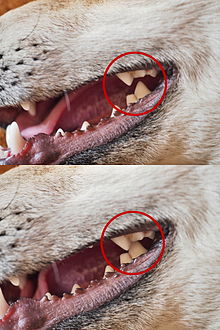Scissor bite

A scissor bite is a set of teeth in which the teeth do not converge vertically, but just pass each other. In contrast to incisors or molars , the sharp surfaces of the teeth do not oppose each other when the jaw is closed, but lie like the edges of closed scissors , hence the name.
Distribution in the animal kingdom
This tooth position is very effective for chopping up meat and bones, but this type of dentition was seldom found in the animal kingdom. Fish , amphibians and reptiles have usually not developed scissor bites, although there were many large prey-grabbing and carnivorous species, especially among reptiles.
functionality
When the jaw closes, the sharp surfaces of the teeth just slide past each other and can thus cut a small, disc-like chunk from a piece of meat - it is sheared off.
Crushing shears
As a special feature within the scissor position of the dentition, the 4th premolars of the upper jaw and the 1st molars of the lower jaw (P4 / M1) are designed as so-called crushing scissors in all land predators, including dogs, for example , whose serrated profile still supports and supports the shear effect which can bite very powerfully due to their favorable leverage. They are also called fangs (not to be confused with the canines or fangs, which are used to hold on but not to crush prey).
advantages
Some predators are able to grate meat and even bones through continued biting at a low speed and thus bring them into a pulpy form. This enables them to do without molars entirely and yet greatly increase the surface area of the food. In cats , this principle is additionally supported by the rough tongue.
Scissor-bite carnivores do not need to swallow larger chunks, which allows for more effective digestion , leaner digestive organs and less physical strain from the digestive process. The provision of large quantities of acidic digestive juices typical of reptiles as well as a well-developed system of secretion and absorption are eliminated. Even predators that eat a lot of meat at once digest it comparatively quickly and can do without extended periods of rest after eating. The esophagus is not designed to expand significantly, which affects the other organs in the neck area and the position from head to trunk.
The scissor bite does not exclude the consumption of plant-based food, but is significantly more inefficient than a set of molars.
Individual evidence
- ↑ Holger Schlemper, Isabell Herold, Tilman Simon: Practical Guide to Dental and Jaw Diseases of the Horse . Georg Thieme Verlag, November 19, 2008, ISBN 978-3-8304-4201-1 , p. 96–.
- ↑ Franz-Viktor Salomon: Teeth . In: Franz-Viktor Salomon u. a. (Ed.): Anatomy for veterinary medicine. Enke-Verlag, Stuttgart 3rd edition, 2015, p. 274. ISBN 978-3-8304-1288-5 .
- ^ Carsten Vogt: Textbook of dentistry in horses . Schattauer Verlag, 2011, ISBN 978-3-7945-2690-1 , pp. 141–.

